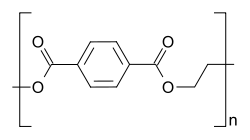Condensation polymer

Condensation polymers are any kind of polymers formed through a condensation reaction—where molecules join together—losing small molecules as byproducts such as water or methanol. Condensation polymers are formed by polycondensation, when the polymer is formed by condensation reactions between species of all degrees of polymerization, or by condensative chain polymerization, when the polymer is formed by sequential addition (by condensation reaction) of monomers to an active site in a chain reaction. The main alternative forms of polymerization are chain polymerization and polyaddition, both of which give addition polymers.
Condensation polymerization is a form of step-growth polymerization. Linear polymers are produced from bifunctional monomers, i.e. compounds with two reactive end groups. Common condensation polymers include polyamides, polyacetals, and proteins.[1][2]
Polyamides
One important class of condensation polymers are polyamides.[3] They arise from the reaction of carboxylic acid and an amine. Examples include nylons and proteins. When prepared from amino-carboxylic acids, e.g. amino acids, the stoichiometry of the polymerization includes co-formation of water:
- n H2N-X-CO2H → [HN-X-C(O)]n + n H2O
When prepared from diamines and dicarboxylic acids, e.g. the production of nylon 66, the polymerization produces two molecules of water per repeat unit:
- n H2N-X-NH2 + n HO2C-Y-CO2H → [HN-X-NHC(O)-Y-C(O)]n + 2n H2O
 General chemical structure of one type of condensation polymer
General chemical structure of one type of condensation polymer
Polyesters
One important class of condensation polymers are polyesters.[4] They arise from the reaction of carboxylic acid and an alcohol. Examples include polyesters, e.g. polyethyleneterephthalate:
- n HO-X-OH + n HO2C-y-CO2H → [O-X-O2C-Y-C(O)]n + 2n H2O
-3-hydroxybutyrat.svg.png)
Safety and environmental considerations
Condensation polymers tend to be more biodegradable than addition polymers. The peptide or ester bonds between monomers can be hydrolysed, especially in the presence of catalysts or bacterial enzymes .
See also
References
- ↑ Introduction to Polymers 1987 R.J. Young Chapman & Hall ISBN 0-412-22170-5
- ↑ D. Margerison, G. C. East, J. E. Spice (1967). An Introduction to Polymer Chemistry. Pergamon Press. ISBN 978-0-08-011891-8.
- ↑ B. Herzog, M. I. Kohan, S. A. Mestemacher, R. U. Pagilagan, K. Redmond (2013). "Polyamides". Ullmann's Encyclopedia of Industrial Chemistry. Weinheim: Wiley-VCH. doi:10.1002/14356007.a21_179.pub3.
- ↑ Horst Köpnick, Manfred Schmidt, Wilhelm Brügging, Jörn Rüter, Walter Kaminsky (2002). "Polyesters". Ullmann's Encyclopedia of Industrial Chemistry. Weinheim: Wiley-VCH. doi:10.1002/14356007.a21_227.
External links
| Wikimedia Commons has media related to Condensation polymerization. |